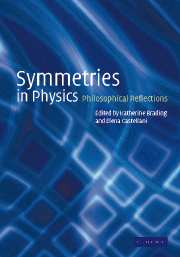Book contents
- Frontmatter
- Contents
- List of contributors
- Preface
- Copyright acknowledgements
- 1 Introduction
- Part I Continuous symmetries
- Part II Discrete symmetries
- Part III Symmetry breaking
- 17 Classic texts: extracts from Curie and Weyl
- 18 Cross fertilization in theoretical physics: the case of condensed matter and particle physics
- 19 On the meaning of symmetry breaking
- 20 Rough guide to spontaneous symmetry breaking
- 21 Spontaneous symmetry breaking: theoretical arguments and philosophical problems
- Part IV General interpretative issues
- Index
21 - Spontaneous symmetry breaking: theoretical arguments and philosophical problems
Published online by Cambridge University Press: 08 October 2009
- Frontmatter
- Contents
- List of contributors
- Preface
- Copyright acknowledgements
- 1 Introduction
- Part I Continuous symmetries
- Part II Discrete symmetries
- Part III Symmetry breaking
- 17 Classic texts: extracts from Curie and Weyl
- 18 Cross fertilization in theoretical physics: the case of condensed matter and particle physics
- 19 On the meaning of symmetry breaking
- 20 Rough guide to spontaneous symmetry breaking
- 21 Spontaneous symmetry breaking: theoretical arguments and philosophical problems
- Part IV General interpretative issues
- Index
Summary
Introduction
Arguments regarding the ontological status of symmetries typically involve questions such as the following: how does the mathematics of symmetry relate to the matter of the physical world and do we have good reasons for thinking that the symmetries inherent in the mathematical structure of our theories have a counterpart in the physical world? In cases where there seems to be a corresponding relation between the symmetries present in the physical system (e.g. rotational and translational symmetries) and the symmetries in the equations that govern this system, one might think the relation is relatively straightforward and that the former is simply an empirical manifestation of the latter. But our questions are complicated by the fact that spontaneous symmetry breaking (SSB) is also a crucial feature of modern physics. In cases such as these the physical system displays none of the symmetry present in the equations that govern it. This symmetry is sometimes referred to as a hidden symmetry so the question, then, becomes one of determining whether the symmetry of the equation should be interpreted in a realistic way given that it seems to have no empirical manifestation.
But perhaps this notion of a ‘hidden’ symmetry should not raise philosophical worries, especially given that SSB lies at the foundation of some of the most successful theories in physics – superconductivity and quantum field theory (QFT) to name just two.
- Type
- Chapter
- Information
- Symmetries in PhysicsPhilosophical Reflections, pp. 347 - 364Publisher: Cambridge University PressPrint publication year: 2003
- 10
- Cited by



